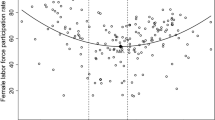Abstract
This essay explores the prospects for unionism throughout the world in the next century. It begins by examining the prospects for democracy and presupposes that employee organizations will emerge in democratic societies. Although there seems to be little chance that many nondemocratic countries will embrace democracy, some form of worker organization may emerge in some of these countries. Unionism in many democratic countries, however, is waning, so the prospects for unionism throughout the world are not very good.
Similar content being viewed by others
References
Anderson, Charles W.Politics and Economic Change in Latin America (New York: Von Nostrand, 1967), Chapter 4.
Barbash, Jack. “Trade Unionism from Roosevelt to Reagan.”The Annuals of the American Academy of Political and Social Science: The Future of American Unionism vol. 473 (May 1984).
_____. “Trade Unionism.” In Richard L. Rowan’sReading in Labor Economics and Labor Relations (Homewood, Ill.: Irwin, 1985) pp. 13–16 and 21–22.
Dahl, Robert A.Polyarchy: Participation and Opposition (New Haven: Yale University Press, 1971), pp. 1–16.
Freeman, Richard B. “Why Are Unions Fairing Poorly in NLRB Representation Elections?” In Richard L. Rowan’sReadings in Labor Economics and Labor Relations (Homewood, Ill.: Irwin, 1985), pp. 129–142.
Gastil, Raymond D. “The Comparative Study of Freedom 1984.”Freedom at Issue (January–February 1984), pp. 3–15, 26–27.
Hamermesh, Daniel S. and Albert Rees.The Economics of Work and Pay (New York: Harper & Row, 1984), pp. 205–207.
Harbison, Frederick. “American Labor and the World Crisis.” Industrial Relations Research Association,Papers, 9th Annual Meeting (1956), pp. 50–82.
Heshizer, Brian and Harry Graham. “Are Unions Facing a Crisis? Labor Officials Are Divided.”Monthly Labor Review (August 1984), pp. 23–25.
Hughey, Michael W. “The New Conservatism: Political Ideology and Class Structure in America.”Social Research 49 (1984), p. 791.
Huntington, Samuel P. “Will More Countries Become Democratic?”Political Science Quarterly 99 (1984), pp. 193–218.
Industrial Relations Research Association.The Work Ethic: A Critical Analysis (Madison, Wisconsin: Pantograph, 1983), Chapters 1, 5, and 7.
Karatnycky, Adrian, Alexander J. Motyl, and Adolph Sturmthal.Workers Rights, East and West (New Brunswick, N.J. Transactions Books, 1980).
Kassalow, Everett M. “The Future of American Unionism: A Comparative Perspective.”The Annuals of the American Academy of Political and Social Science: The Future of American Unionism vol. 473 (May 1984).
Linz, Juan L. “An Authoritarian Regime: Spain.” In Erik Allarot and Yrjo Littonen’s,Cleavages, Ideologies, and Party Systems: Contributions to Comparative Political Sociology vol. 10 (Helsinki Academic Bookstore, 1969), pp. 297–299.
Lipset, Seymour M. “Social Requisites of Democracy: Economic Development and Political Legitimacy.”American Political Science Review vol. 53 (1959), pp. 69–105.
Neumann, George R. and Ellen R. Rissman. “Where Have All the Union Members Gone?”Journal of Labor Economics 2 (1984), p. 175.
O’Donnell, Guillillerno.Modernization and Bureaucratic-Authoritarionism: Studies in South American Politics (Berkeley: Institute for International Studies, University of California, 1972).
Ruble, Blair A.Soviet Trade Unions: Their Development in the 1970s (London: Cambridge University Press, 1981).
Rustow, Dankwart A. “Transitions to Democracy: Toward a Dynamic Model.”Comparative Politics vol. 2 (1970).
Siegel, Abraham. “American Labor and the World Crisis.” Industrial Relations Research Association,Papers, 9th Annual Meeting (1956), pp. 50–82.
Stephens, Joseph.The Transition from Capitalism to Socialism (New York: Academic Press, 1980).
Stieber, Jack. “Most US Workers Still May Be Fired Under Employment-at-Will.”Monthly Labor Review 107 (May 1984), pp. 34–38.
Wedderbern, Lord, Roy Lewis, and Jon Clark.Labor Law and Industrial Relations: Building on Kahn-Frued (Oxford: Clarendon Press, 1983), pp. 138–140, 142–143, 175–178, and 207–209.
Wiarda, Howard J. “Corporate Origins of the Iberian and Latin American Labor Relations Systems.”Studies in Comparative International Development (Spring 1978), pp. 3–37.
Witte, Edwin. “The Crisis in American Unionism.” National Academy of Arbitrators,Proceedings (1958), pp. 172–187.
Author information
Authors and Affiliations
Additional information
The author is indebted to Kenneth W. Coleman for considerable guidance.
Rights and permissions
About this article
Cite this article
Krislov, J. Unions in the next century: An exploratory essay. Journal of Labor Research 7, 165–173 (1986). https://doi.org/10.1007/BF02685308
Issue Date:
DOI: https://doi.org/10.1007/BF02685308




